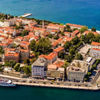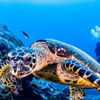
Highlights and excursions around Salalah

Salalah: the Caribbean of the Orient
Located in the south of the Sultanate of Oman, Salalah is the country’s second-largest city. As a former centre for the trade in frankincense, it is also of archaeological interest; the relics of the medieval port city of Al-Baleed on the lagoon in the east of the modern city are UNESCO World Heritage sites. When it gets colder in Europe, Salalah has ideal temperatures for beach holidays. And not only that: the white, palm-lined sandy beaches and turquoise waters make such a paradise that the region is also called the Caribbean of the Orient – and rightly so.


Dreamy beaches and blowholes
Salalah has such a vast selection of dream beaches that you can visit a different one virtually every day. Popular spots include Al Haffa Beach, Dahariz Beach, Taqa Beach in East Salalah, and Masood and Fazayah Beaches in West Salalah. Near these two beaches, the fishing village of Mughsail has one of the country’s most exciting and beautiful sandy beaches. Because here, on Mughsail Beach, is where you find the famous “blowholes”: a long wooden walkway leads to a rock plateau that has been washed from beneath by the Indian Ocean over the millennia. In the event of strong sea swell, up to ten-metre-high water fountains shoot out of the rock holes. Make sure to bring towels!


Sunset in the desert
A trip to the Rub’ al-Khali Desert, the largest sand desert in the world, is of course a must-see when visiting Oman. For example, a sunset tour: starting with a coffee in the desert city of Thumrait, an hour’s drive from Salalah, you’ll learn about rare black dromedaries and many details about their importance in Omani culture. The cross-tour over the sand dunes guarantees an adrenaline rush, where the driver can really put the pedal to the metal. On the crest of the dunes, you can end the day and watch the sunset over some snacks and drinks – this trip offers opportunities for great photo motifs.


Wadi Darbat: the green valley
A 40-minute drive from Salalah, Wadi Darbat is home to Oman’s most beautiful waterfalls – not quite as powerful during the winter as during the monsoon from June to September, but they’re definitely worth a visit. Wadi Darbat is a fantastic place for hikes, boat tours and wildlife watching, especially the birdlife. Many free-running camels are also on the road in this valley, and you will often encounter them by the water. Bathing is forbidden here due to the risk of schistosomiasis – but not for the animals, of course.


Diving – ideally in winter
Salalah is a unique spot for diving, but only in winter: from October to December you, can dive in kelp forests, which are algae and plankton forests beneath the surface of the water that store enormous amounts of CO₂. From January to April, you might even see humpback whales or orcas, as the area has an enormous wealth of fish. The diving stations are accessed by boat from the fishing harbour and are between seven and 30 metres deep. You will find moray eels, flathead fish, squid, sardines, turtles, rays and mantas.


Al-Baleed and the Museum of the Frankincense Land
On the Al-Baleed headland in the east of Salalah, there is a UNESCO World Heritage Site: the remains of a medieval port city. A particularly impressive feature of the Archaeological Park are the remains of the large court mosque with its 148 columns and the historic frankincense port. The “Museum of the Frankincense Land” provides an insight into the fascinating maritime history of the country and the historical significance of the city of Salalah as the centre of the frankincense trade. Because the Dhofar region is where the unique frankincense trees (whose resin is used as incense) grow.

Modern architecture in the Sultan Qaboos Mosque
From 1970 to 2020, Sultan Qaboos bin Said Al Said controlled the country’s destiny. He rapidly brought Oman from the spiritual Middle Ages into the 21st century and donated two magnificent mosques to its people: the enormous main mosque in Muscat and its somewhat smaller counterpart in Salalah, the birthplace of the Sultan. It is the largest mosque in Dhofar, with space for 3,200 worshippers. The sacred white building, which is surrounded by a total of four hectares of exquisitely manicured gardens, was inaugurated in 2009. Two slim minarets and a 36-metre-high dome adorn the mosque. In the quiet rooms, Ibadis, Sunnis and Shiites pray peacefully next to each other. Visitors are asked to wear clothing covering the arms and legs, and women should place a cloth over their hair.

The Tomb of Job
Around 20 kilometres from Salalah lies a small pilgrimage site visited by Muslims, but also by believers of the other two monotheistic world religions: the tomb of the prophet Job, which in the Quran is called Nabi Ayoub. The good man who remained true to his belief despite his misfortune and suffering had to withstand a lot of bad news that was brought to him by heavenly messengers – that’s where the phrase “Job’s news” comes from. The mausoleum is located in the mountains in the middle of a very beautiful garden. As in all the sacred places in Oman, there is also a dress code here: covered arms and legs, women need a cloth over their hair.


Great road trip: from Muscat to Salalah
If you want to combine culture, natural adventures and dreamy beach holidays during your holidays, Oman is the perfect destination. From Muscat, the oriental metropolis with its many attractions, the 1,000 kilometres along the coast towards the south is worthwhile. Take your time, plan for at least four days, or better even more. Along the way, you can see great wadis like Ash Shuwaymiyah, which invites you to hike, with desert sections, tortoise beaches, cliffs and flamingos, and very ancient places like the fishing and market town of Al-Ashkhara, where you can stay. After a few restful days of bathing, Edelweiss will take you back to Switzerland.








